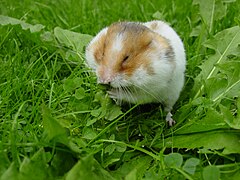Cricetinae
| Hamster Temporal range: Middle Miocene–Current |
|
|---|---|
 |
|
| A Syrian hamster filling his cheek pouches with Dandelion leaves. | |
| Scientific classification | |
| Kingdom: | Animalia |
| Phylum: | Chordata |
| Class: | Mammalia |
| Order: | Rodentia |
| Family: | Cricetidae |
| Subfamily: |
Cricetinae Fischer de Waldheim, 1817 |
| Genera | |
|
Mesocricetus |
|
Mesocricetus
Phodopus
Cricetus
Cricetulus
Allocricetulus
Cansumys
Tscherskia
Hamsters are rodents belonging to the subfamily Cricetinae. The subfamily contains about 25 species, classified in six or seven genera. They have become established as popular small house pets, and partly because they are easy to breed in captivity, hamsters are often used as laboratory animals.
In the wild, hamsters are crepuscular and remain underground during the day to avoid being caught by predators. They feed primarily on seeds, fruits, and vegetation, and will occasionally eat burrowing insects. They have elongated cheek pouches extending to their shoulders in which they carry food back to their burrows.
Although the Syrian hamster or golden hamster (Mesocricetus auratus) was first described scientifically by George Robert Waterhouse in 1839, researchers were not able to successfully breed and domesticate hamsters until 1939. The entire laboratory and pet populations of Syrian hamsters appear to be descendants of a single brother–sister pairing. These littermates were captured and imported in 1930 from Aleppo in Syria by Israel Aharoni, a zoologist of the University of Jerusalem. In Jerusalem, the hamsters bred very successfully. Years later, animals of this original breeding colony were exported to the USA, where Syrian hamsters became one of the most popular pets and laboratory animals. Comparative studies of domestic and wild Syrian hamsters have shown reduced genetic variability in the domestic strain. However, the differences in behavioral, chronobiological, morphometrical, hematological, and biochemical parameters are relatively small and fall into the expected range of interstrain variations in other laboratory animals.
...
Wikipedia
